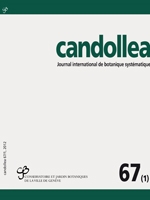Stauffer, F. W., J. Stauffer & L. J. Dorr (2012). Bonpland and Humboldt specimens, field notes, and herbaria; new insights from a study of the monocotyledons collected in Venezuela. Candollea 67: 75–130. In English, English and French abstracts.
The monocotyledon collections emanating from Humboldt and Bonpland's expedition are used to trace the complicated ways in which botanical specimens collected by the expedition were returned to Europe, to describe the present location and to explore the relationship between specimens, field notes, and descriptions published in the multi-volume “Nova Genera et Species Plantarum” (1816–1825). Collections in five European herbaria were searched for monocotyledons collected by the explorers. In Paris, a search of the Bonpland Herbarium (P-Bonpl.), the most important repository of the expedition's botanical collections, uncovered about 350 specimens of monocotyledon and more or less the same number of species. The Venezuelan material represents 86 species belonging to 57 genera and 19 families. Curiously, 235 species of monocotyledon described in the “Nova Genera et Species Plantarum” are not represented now by specimens in the Bonpland Herbarium although 32 of these 235 are represented by illustrations (i.e., grisailles). No material whatsoever could be found for 203 species of monocotyledon that were expected to be documented by specimens in this herbarium. In Berlin, the Willdenow Herbarium (B-W) holds at least 126 specimens of monocotyledon from Venezuela, corresponding to the same number of species distributed in 64 genera and 26 families. The Berlin herbarium (B) received expedition collections when it purchased the herbarium of Karl Sigismund Kunth. We discovered several specimens of monocotyledon from Venezuela in the herbarium HAL, and they are duplicates of specimens in the Willdenow Herbarium that were removed by D. F. L. von Schlechtendal. No monocotyledon material tied to Humboldt and Bonpland was discovered in the herbarium MA-CAV even though there is evidence that seed was sent by the explorers from Venezuela, cultivated in Madrid, and on occasion these garden-grown plants vouchered as herbarium specimens. Similarly, no monocotyledon material was found in the herbarium LR, despite evidence in correspondence that Bonpland sent specimens to his older brother. We believe that evidence contained in the field books favors describing the botanical collections as being made by “Bonpland and Humboldt” and not “Humboldt and Bonpland”, as is commonly done. The same field books, correspondence, and the introduction to “Nova Genera et Species Plantarum” favor a collective authorship such as “Kunth, Bonpland & Humboldt” rather than “Kunth in H.B.K.” for taxa described in this work. This seems particularly appropriate for those taxa described in these volumes that are not vouchered now by specimens or illustrations in P-Bonpl.





